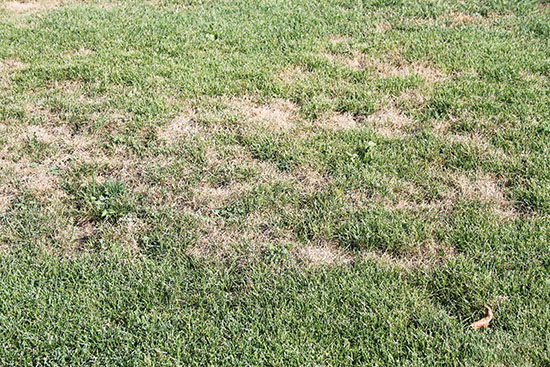Issue 11, July 28, 2014
Chinch Bug
We have recently received reports of chinch bug damage in turf. Chinch bugs are typically not much of a turf problem in Illinois, being more of a pest problem in the Great Plains region. One reason for this is that chinch bug is attacked by a naturally occurring fungal pathogen, Beauvaria bassiana. This causes all stages, eggs, nymphs, and adults, to be killed and covered with fine white fungal strands. As with fungi that attack plants, they do better under cool, moist conditions. In Illinois, we typically get enough rainfall throughout the season that the fungus controls the chinch bugs for us, free of charge.
The other factor in chinch bug abundance is nitrogen. Chinch bugs, along with many other sap-sucking insects, are healthier and reproduce more on plants containing high levels of nitrogen. In many areas, landscapers and lawn care professionals feel that they are forced to overapply nitrogen fertilization to turfgrass to satisfy their clients' demands for greener lawns. This excess nitrogen results in many more chinch bugs than would normally be present. In addition, excess nitrogen tends to result in increased thatch, allowing the chinch bugs to live in that area rather than against the soil where it tends to stay moist and the fungus is more prevalent.
The infestations this year have been in turf with thick thatch layers, probably caused by high nitrogen application. We have certainly had enough rainfall to provide the moisture that the chinch bug attacking fungus needs, but the bugs have been able to avoid it by living in the quickly-drying thatch.
Damaged turf is light tan in color, looking like straw. Due to the high-nitrogen factor, adjoining lawns that have not received as much nitrogen fertilization typically show no damage. To find the chinch bugs, push the grass blades to the side with your fingers to reveal the crowns of the grass plants, and the bugs will be evident at the base of the shoots. Another way to scout for chinch bugs is to push a coffee can or similar can down into the turf and fill it with water. The bugs will pop to the water surface and accumulate around the edge of the can. The threshold for treatment is a solid line of chinch bugs where the water meets the can.

Chinch bug damage.
Two species of chinch bugs attack Illinois turfgrass. Hairy chinch bugs are found in northern Illinois, where they attack Kentucky bluegrass, fine fescues, perennial ryegrass, bentgrass, and zoysiagrass. Common chinch bug occurs in central and southern Illinois and feeds on the same grass species, as well as field grain crops such as wheat, corn, and sorghum. Both are similar in appearance and habits.

Common chinch bug nymphs and adults.
Adult chinch bugs overwinter in the crowns of grasses. They become active in the spring. They are about 1/8 inch long, long oval-shaped, and are black and white, due to wing coloration. Some adults have short wings and appear black. Nymphs are bright orange with a white band, turning to black as they go through five instars (stages). First-instar nymphs are about 1/32 inch long and grow up to be /8 inch-long fifth-instar nymphs.
Control chinch bugs with a spray of bifenthrin (Onyx, Talstar), deltamethrin (DeltaGard), lambda-cyhalothrin (Scimitar), or trichlorfon (Dylox). (Phil Nixon)
Author:
Phil Nixon